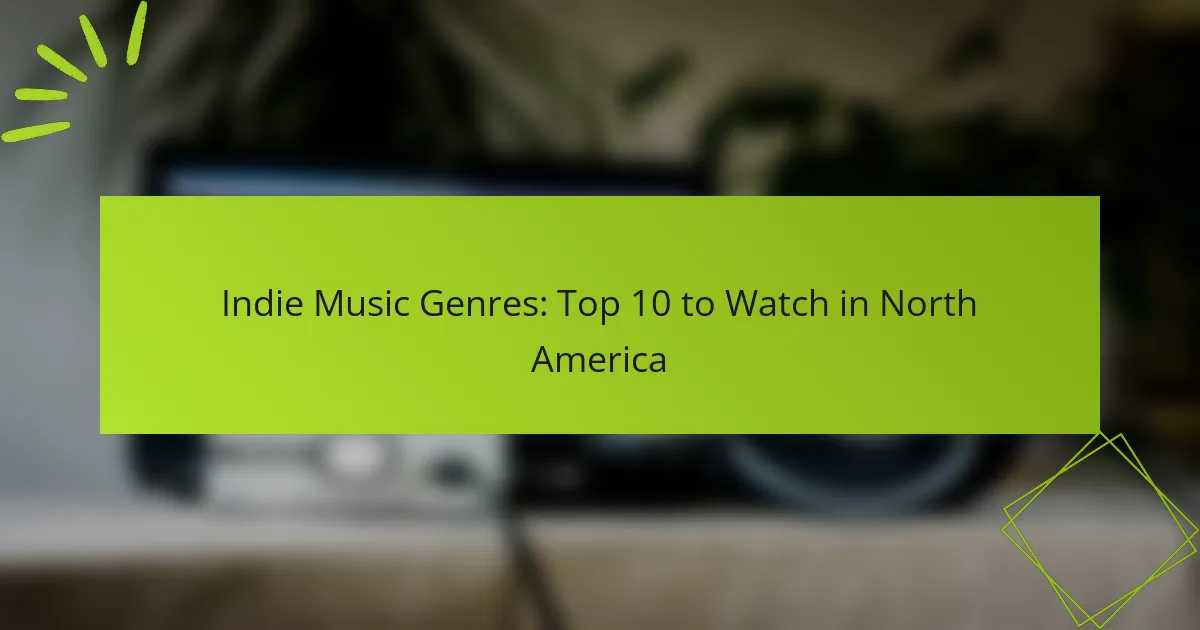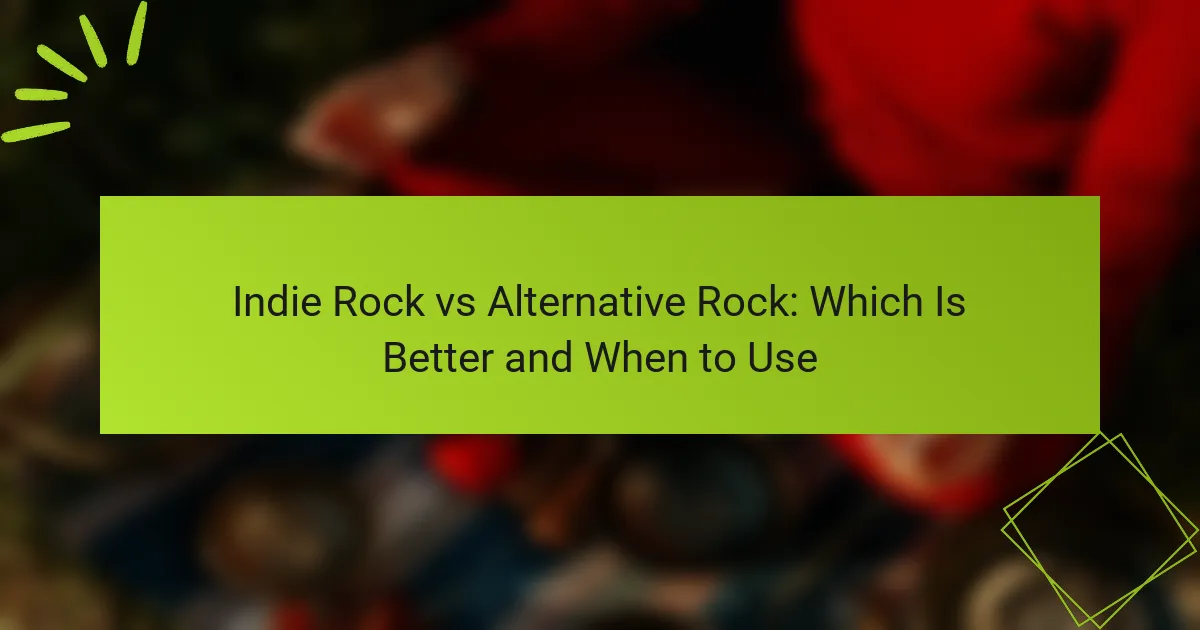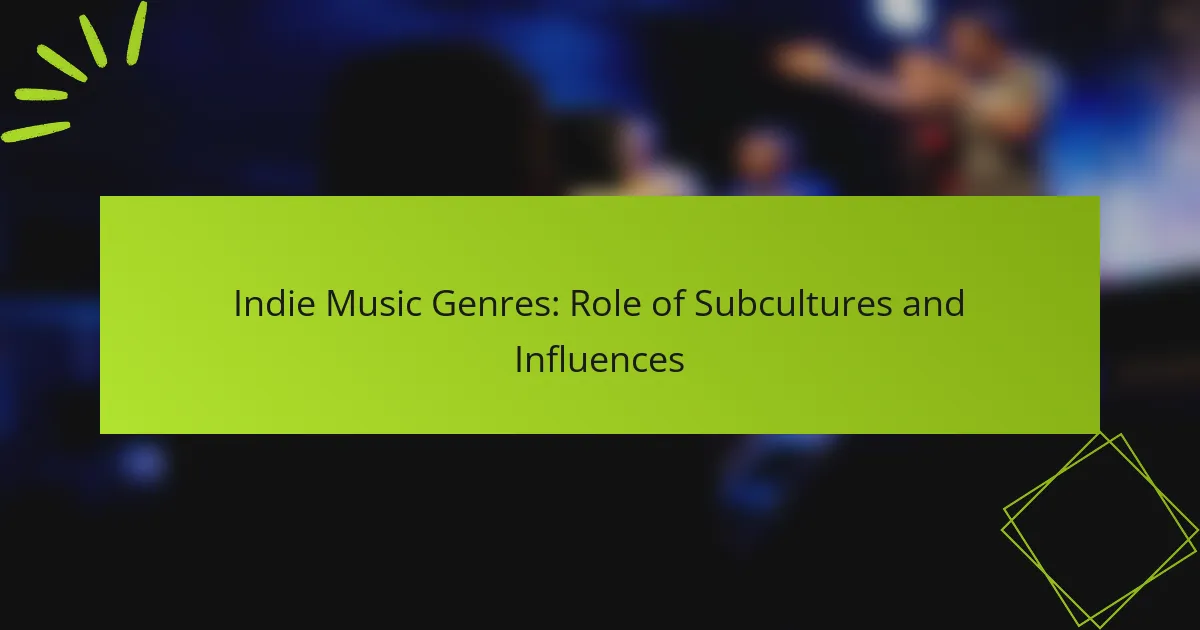Indie music in North America is thriving with a rich variety of genres that mirror the cultural landscape and shifting musical preferences. Genres such as indie pop, rock, and electronic are on the rise, captivating audiences and nurturing a dynamic music scene that values authenticity and community. As these genres continue to evolve, they offer listeners a refreshing alternative to mainstream sounds, making them essential to watch in the coming years.
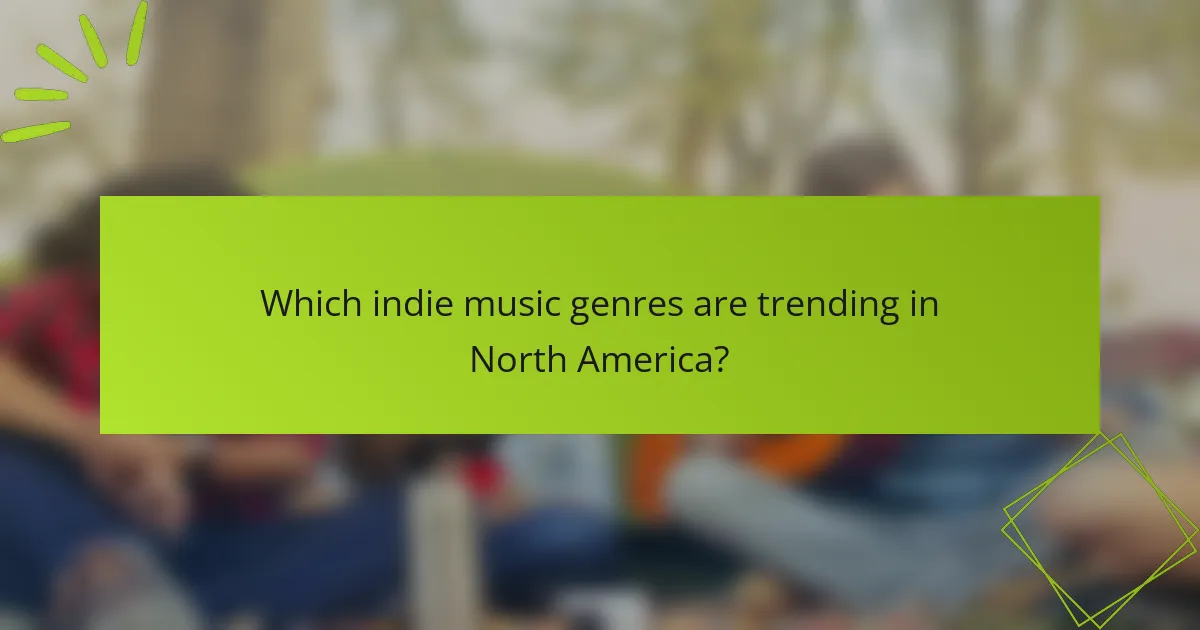
Which indie music genres are trending in North America?
Indie music in North America is currently characterized by a diverse range of genres that reflect both cultural shifts and evolving musical tastes. Key genres like indie pop, rock, and electronic are gaining traction, appealing to a wide audience and fostering a vibrant music scene.
Indie Pop
Indie pop is known for its catchy melodies and upbeat sound, often incorporating elements from various genres like synth-pop and folk. Artists in this genre typically focus on relatable lyrics and accessible production, making it appealing to a broad audience.
Notable indie pop artists include Phoebe Bridgers and Clairo, who have gained significant popularity in recent years. Their music often features a blend of personal storytelling and experimental sounds, reflecting the genre’s versatility.
Indie Rock
Indie rock combines a range of influences, from classic rock to punk, creating a sound that is both raw and polished. This genre often emphasizes guitar-driven melodies and introspective lyrics, attracting listeners who appreciate authenticity in music.
Prominent indie rock bands like Arctic Monkeys and Vampire Weekend have made substantial impacts on the music landscape. Their innovative approaches to songwriting and production have set trends within the genre, influencing emerging artists across North America.
Folk Indie
Folk indie merges traditional folk music elements with contemporary indie styles, resulting in a sound that is both nostalgic and fresh. Artists often use acoustic instruments and storytelling lyrics to create an intimate atmosphere.
Musicians like Sufjan Stevens and Iron & Wine exemplify this genre, often exploring themes of love, loss, and nature. Their music resonates with audiences seeking depth and emotional connection in their listening experience.
Lo-fi Indie
Lo-fi indie is characterized by its raw, unpolished sound, often featuring home recordings and minimal production. This genre embraces imperfections, creating a sense of authenticity and intimacy that appeals to many listeners.
Artists such as Mac DeMarco and Snail Mail have popularized lo-fi indie, often using simple instrumentation and relatable lyrics. This genre is particularly appealing to younger audiences who appreciate a laid-back, DIY approach to music.
Indie Electronic
Indie electronic blends electronic music elements with indie sensibilities, creating a unique sound that often features synths, beats, and experimental production techniques. This genre has gained popularity for its ability to push musical boundaries while remaining accessible.
Artists like ODESZA and Grimes have successfully merged these styles, resulting in music that is both danceable and thought-provoking. The genre continues to evolve, attracting a diverse audience and fostering innovative collaborations within the music community.

What makes these indie genres popular?
Indie music genres have gained popularity in North America due to their distinctive sounds, grassroots origins, and the ability to connect directly with audiences. These elements foster a sense of community and authenticity that resonates with listeners seeking alternatives to mainstream music.
Unique sound
The unique sound of indie music often blends various genres, creating innovative and eclectic styles. Artists experiment with instrumentation, production techniques, and lyrical themes, resulting in a diverse range of music that can appeal to different tastes.
For example, genres like indie folk combine traditional acoustic elements with modern storytelling, while indie rock may incorporate electronic influences. This variety allows listeners to discover new sounds that challenge conventional music norms.
DIY culture
The DIY culture prevalent in indie music encourages artists to take control of their creative processes. Many musicians produce, record, and distribute their music independently, often using affordable technology and platforms to reach audiences directly.
This approach not only fosters creativity but also allows for greater artistic freedom. Artists can explore their vision without the constraints of major label expectations, resulting in authentic and personal music that resonates with fans.
Social media influence
Social media has transformed how indie artists promote their music and connect with fans. Platforms like Instagram, TikTok, and Bandcamp enable musicians to share their work, engage with audiences, and build a following without traditional marketing budgets.
For instance, viral trends on TikTok can propel an indie song to widespread recognition, showcasing the power of social media in shaping music careers. This direct interaction fosters a loyal fanbase that appreciates the artist’s journey and supports their work.

How to discover new indie music?
To discover new indie music, explore various platforms and resources that showcase emerging artists and genres. Engaging with streaming services, music blogs, and live performances can significantly enhance your exposure to fresh sounds and innovative talent.
Streaming platforms
Streaming platforms are essential for discovering new indie music, as they often feature curated playlists and recommendations tailored to your listening habits. Services like Spotify, Apple Music, and Bandcamp allow you to explore genres and follow artists, making it easier to find hidden gems.
Look for playlists specifically dedicated to indie music, such as “Indie Essentials” or “Fresh Finds.” These playlists are regularly updated, providing a steady stream of new tracks to enjoy. Additionally, many platforms offer user-generated playlists that can introduce you to lesser-known artists.
Music blogs
Music blogs are another valuable resource for discovering indie music, as they often provide in-depth reviews and features on up-and-coming artists. Websites like Pitchfork, Stereogum, and Indie Shuffle regularly highlight new releases and trends in the indie scene.
Follow blogs that align with your musical tastes and subscribe to their newsletters for the latest updates. Many blogs also host interviews and live sessions, giving you a deeper understanding of the artists and their creative processes.
Live shows
Attending live shows is a fantastic way to discover new indie music and support local artists. Many cities in North America host indie music festivals and local gigs, where you can experience the energy of live performances and connect with the music community.
Check local venues and event listings for upcoming shows, and consider joining social media groups or platforms like Songkick to stay informed about performances in your area. Engaging with artists and fellow fans at these events can lead to discovering even more music that resonates with you.
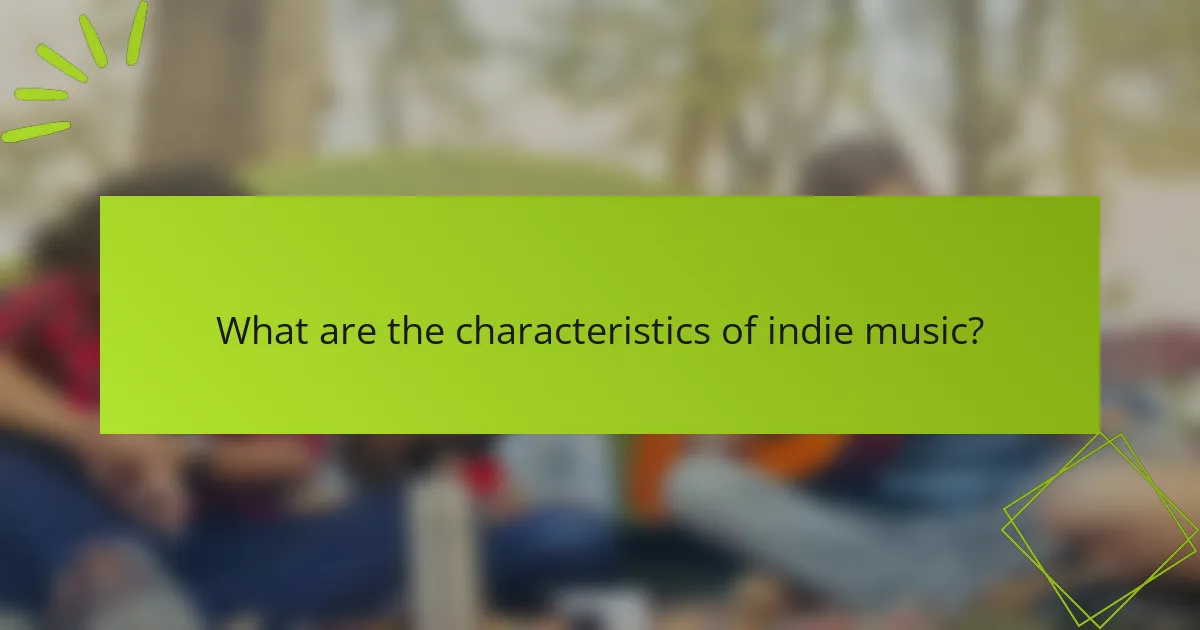
What are the characteristics of indie music?
Indie music is characterized by its emphasis on artistic expression, diverse sounds, and a strong focus on lyrics. Artists often operate outside major record labels, allowing for greater creative control and innovation.
Artistic freedom
Artistic freedom in indie music means that musicians can explore unconventional themes and sounds without the constraints imposed by commercial pressures. This independence allows for unique storytelling and experimentation, resulting in a wide range of musical styles.
Many indie artists choose to self-produce their music, which further enhances their creative liberty. This approach often leads to a more authentic sound that resonates with listeners seeking originality.
Varied instrumentation
Indie music often features a diverse array of instruments, ranging from traditional guitars and drums to unconventional choices like ukuleles, synthesizers, or even household items. This variety contributes to the genre’s rich sound palette.
Artists frequently blend genres, incorporating elements from folk, rock, electronic, and more. This eclectic mix allows for innovative compositions that can appeal to a broad audience.
Emphasis on lyrics
Lyrics in indie music are typically introspective and thought-provoking, often reflecting personal experiences or social commentary. This focus on storytelling sets indie apart from more mainstream genres that may prioritize catchy hooks over lyrical depth.
Listeners are drawn to the emotional resonance and relatability of indie lyrics, which often tackle themes like love, identity, and existential questions. This connection fosters a loyal fan base that values the narrative behind the music.
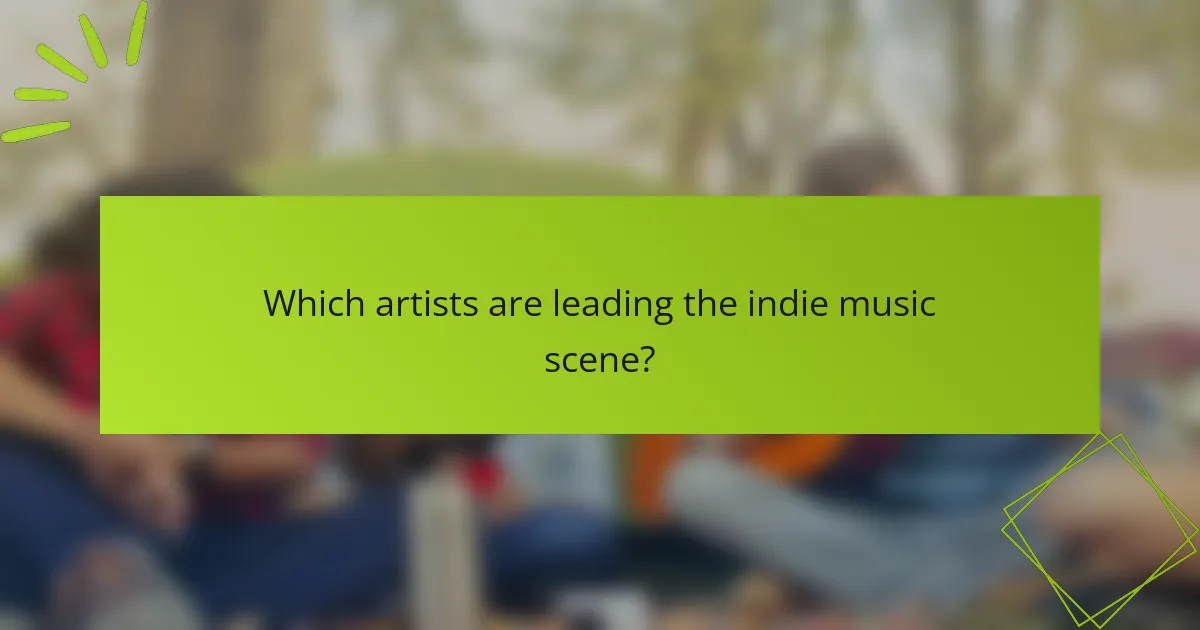
Which artists are leading the indie music scene?
The indie music scene in North America is vibrant and diverse, with several artists making significant impacts. These musicians are known for their unique sounds, innovative approaches, and strong connections with their audiences.
Phoebe Bridgers
Phoebe Bridgers has emerged as a prominent figure in the indie music landscape, captivating listeners with her introspective lyrics and haunting melodies. Her debut album, “Stranger in the Alps,” received critical acclaim and showcased her ability to blend folk and rock elements seamlessly.
Bridgers’ collaborations with other artists, such as Conor Oberst in their project Better Oblivion Community Center, further highlight her versatility and appeal. She often addresses themes of mental health and personal struggles, resonating deeply with her audience.
To explore her music, consider starting with her singles like “Motion Sickness” and “Kyoto,” which exemplify her signature style. Attending her live performances can also provide an immersive experience, as her emotional delivery connects strongly with fans.
